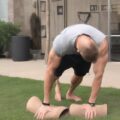Strengthening Your Core and Upper Body with Compassion
When we think about exercise, it’s easy to focus solely on achieving physical results. However, a compassionate approach to fitness can transform our relationship with our bodies and lead to more sustainable, joyful movement practices. Today, we’ll explore upper body and core exercises with a focus on self-kindness and overall wellbeing.
The Mind-Body Connection in Upper Body and Core Work
Our core and upper body are central to many daily activities, from carrying groceries to hugging loved ones. By strengthening these areas with mindfulness, we can cultivate a deeper appreciation for our bodies and their capabilities. As you engage in these exercises, take time to breathe deeply and express gratitude for your body’s efforts.
Gentle Exercises to Build Upper Body and Core Strength
Here are some exercises that target your upper body and core while promoting a sense of calm and body awareness:
- Modified Plank: Start on your knees and forearms, keeping your back straight. Hold this position while focusing on your breath. This exercise builds core strength while allowing you to listen to your body’s limits.
- Wall Push-ups: Stand arm’s length from a wall and place your palms against it. Lean in, bending your elbows, then push back to the starting position. This gentle variation of push-ups is kind to your joints while strengthening your chest and arms.
- Seated Russian Twists: Sit on the floor with your knees bent and feet flat. Lean back slightly, keeping your spine straight. Gently rotate your torso from side to side, moving at a pace that feels comfortable for you.
- Shoulder Blade Squeeze: Stand or sit tall, then squeeze your shoulder blades together. Hold for a few seconds, then release. This simple exercise improves posture and upper back strength.
Remember, the goal isn’t to push yourself to exhaustion, but to move in ways that feel good and sustainable for your body.
Incorporating Mindfulness into Your Routine
As you perform these exercises, practice mindfulness to enhance the mind-body connection:
- Focus on your breath, noticing how it changes as you move
- Pay attention to the sensations in your muscles
- Acknowledge any discomfort without judgment, adjusting as needed
- Express gratitude for your body’s strength and capabilities
By bringing awareness to your practice, you can turn exercise into a form of self-care and meditation.
Nurturing Your Body Beyond Exercise
Remember that building strength is just one aspect of caring for your body. Proper nutrition, adequate rest, and stress management are equally important. Treat your body with kindness by:
- Eating nourishing foods that make you feel good
- Getting enough sleep to support recovery
- Engaging in activities that bring you joy and reduce stress
- Practicing positive self-talk and body acceptance
By taking a holistic approach to your wellbeing, you’ll create a sustainable fitness journey that nurtures both body and mind.
Celebrating Progress, Not Perfection
As you incorporate these exercises into your routine, remember that progress looks different for everyone. Celebrate the small victories, whether it’s holding a plank for a few seconds longer or simply showing up for yourself. Your worth is not determined by your physical abilities, but by the kindness and compassion you show yourself and others.
Frequently Asked Questions
1. How often should I do these exercises?
Listen to your body and start with what feels comfortable. Even 10-15 minutes, 2-3 times a week can make a difference. Gradually increase as you build strength and confidence.
2. Can I do these exercises if I have limited mobility?
Absolutely! These exercises can be modified to suit various abilities. Always consult with a healthcare professional before starting a new exercise routine, especially if you have health concerns or limited mobility.
3. I don’t see immediate results. Should I be concerned?
Not at all. Building strength takes time, and progress isn’t always visible. Focus on how you feel – increased energy, better posture, or improved mood are all signs of positive change.
4. Is it normal to feel sore after these exercises?
Some muscle soreness is normal, especially when you’re just starting out. However, if you experience sharp pain or prolonged discomfort, it’s important to rest and consult a healthcare professional if needed.
5. How can I stay motivated to continue exercising?
Find ways to make exercise enjoyable – play music, exercise with a friend, or combine it with another activity you love. Remember to be kind to yourself and celebrate your efforts, no matter how small they may seem.
Incorporating upper body and core exercises into your routine with compassion and mindfulness can lead to a more fulfilling and sustainable fitness journey. Remember, the goal is not perfection, but rather nurturing a positive relationship with your body and celebrating its incredible capabilities. Be patient with yourself, listen to your body, and enjoy the process of becoming stronger, both physically and mentally.









